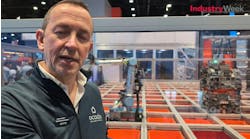Many high-throughput distribution centers face a growing logistics challenge — the need to prepare a wider variety of orders to ship and arrive on schedule and with a near-zero tolerance of errors. Sometimes comprising thousands or tens-of-thousands of different SKUs and in an assortment of package styles, these items need to be stored, picked and stacked on pallets or roll cages ready for outbound transport with a very high level of efficiency to optimize labor usage and minimize operational costs. The product styles include boxes of all sizes, cans and jars in cardboard trays, open and closed cartons, beverages, bags and large, unstable tissue packages.
The number of different SKUs with their varied packaging is growing continually and becoming increasingly difficult to handle with manual and conventional automated systems. Distribution centers (DCs) are also experiencing a growing need to deliver these orders in more store-friendly formats to a diverse and expanding range of store configurations, yet within an environment of rising DC labor costs and stricter safety regulations.
One area of the DC supply chain that has recently experienced a quantum leap in efficiency is automated palletizing for handling a high volume of mixed-SKU cases. By using sophisticated software and articulated, servo-driven robots that receive product in an automated sequence — when functioning as a sub-unit of a larger automated order assembly system — these automated palletizers are capable of rapidly building cube-optimized, virtually error-free, store-ready/aisle-ready pallets.
Evolution in Palletizing
As early as the 1950s, conventional automated palletizers, which could process a single SKU continuously, came into use. By the late 1970s, robotics began to be employed to increase the flexibility of automated systems for singular SKU counts and different palletizing configurations. However, the cycle time was limited due to robot performance. With the introduction of servo-motors in the late 1980s, the speed and performance of single-SKU palletizing systems advanced considerably.
By the late 1990s, with the addition of improved software, mixed SKU palletizing systems — able to handle 350 to 400 SKU counts with limited package variety — began to appear in DCs. Equipped with articulated robots, these systems have proven valuable for DC operations, such as beverage distributors, with a typical low-SKU-count product range.
The first versions of automated high-SKU, mixed-case palletizers became available to the logistics market around 2005. Equipped with four-, five- and six-axis robots and software with expanded capability, these highly-automated systems have begun a new evolution in volume-SKU, mixed-case palletizing.
Now, the latest generation of these systems provides greatly improved software and more versatile product gripping tools, capable of building a higher, more dense and more stable pallet than prior systems, with improvements in system speed, order accuracy and store-friendly flexibility. The latest of these automated, high-volume, mixed-case systems can access tens-of-thousands of SKUs and palletize more than 1,000 mixed cases per hour, averaging 130 different SKUs per pallet (1.2 cases of a particular SKU per pallet).
High-Rate Palletizing
To process and palletize mixed cases at high-speed rates with such high accuracy, product needs to be fed into the system in a sequenced format. This requires supporting an integrated automation upstream solution, consisting of delayering incoming single-SKU pallets, storage, picking and case buffering. The latest mixed-case palletizing units integrate with both high-speed, automated storage and retrieval systems (AS/RS) and conventional pallet racking.
One example of the new high-SKU systems is AMCAP, an automated, mixed-case palletizing system from Dematic Corp., a supplier of logistics automation solutions, systems and service. While referencing some specific capabilities of the Dematic system, this article will illustrate the type of performance improvements available to material handling professionals using any high-rate, mixed-case palletizer.
Sequenced Pallet Builds
The cycle starts with the DC's receipt of product — for example, a trailer load of 22 pallets. Each pallet is entered into the DC's warehouse management system (WMS), which integrates with a warehouse control system (WCS) designed for maximizing performance of order assembly systems. The WCS has inherent f unctionality for running all aspects of the DC's order assembly, including delayering, storage, buffering and sequencing, picking, sortation and palletizing functions.
The incoming pallets are typically stored in a high-bay warehouse storage system. Once stored, the DC's WMS releases the orders to the WCS. The WCS sorts the data based on store requirements (i.e., aisle position) and sends the pallet information to a software package that uses several different attributes of the product (length, width, height, weight, crushability, etc.) as well as the specific store requirements (i.e., aisle position) to determine the build sequence for each pallet.
These pallet builds can be assigned over multiple palletizing units and can be preplanned for a short lead time before the build takes place. The pallets to be built can also be visualized in 3D before each build cycle.
Entire pallets are then automatically or manually delayered and conveyed to high-speed buffering and sequencing systems, where they are stored until needed at the palletizing cells.
Optimized Efficiency
Each palletizer cell (built on a mezzanine) is fed by two conveyors providing the sequenced cases, which are then aligned and oriented and presented to two six-axis, servo-driven articulated arm robots for pick up. The two robots build each pallet cooperatively at a rate of greater than 1,000 mixed-SKU cases per hour. A multi-axis, end-of-arm-tool attached at the end of the robots' articulated arms can handle all standard types of packaging, including boxes of various sizes; cardboard trays; open or closed cartons; bags; and large, unstable containers without stopping or changing tools.
The products are conveyed to a stop location. The robot then approaches the product and precisely picks it up. The package is held in a stable, known position on the tool, so it can be moved rapidly to the proper position on the pallet. The combined dual-robotic cycle of feeding, grabbing and placing the cartons establishes the system's high throughputs.
Once stacking is complete, the pallet is lowered through the mezzanine floor with a lift, and as it is being lowered, it is stretch-wrapped for stability. The completely lowered pallet, now fully stretch-wrapped, has a label applied to it as it comes out on the outbound conveyor. The system then directs the completed order pallet to an output spur for the assigned active trailer to be loaded.
Palletizing, however, continues, even while the built pallet is being removed from the active build area, and only a few seconds are lost in the transition. After the pallet continues down through the mezzanine, slider plates close to form a solid surface. The robots immediately begin stacking cases for the next layer on the next pallet that is being built on these slider plates.
A new pallet is then raised by a lift up to the mezzanine level, the slider plates open, and the cases are dropped onto the new pallet, and the robots continue. The transition from the slider plates to the pallet is done without slowing the robot's performance. This streamlined performance has been facilitated by the coordination between the palletizer's discrete functions — robots, conveyors, lift and slider plates.
Optimized Dispatch Units
The computer-aided determination of the palletizing sequence also increases the pallet density. It builds cube- and volume-optimized pallets with a 90%+ density, compared to the typical 70% to 80% density of manually-produced pallets. The software calculates the packaging contact surfaces and determines the layering of the individual packages; these are critical to producing a stable palletizing pattern.
Within the palletizing system, stacking criteria is modified by a number of factors, including case size and shape, crushability, stability factors, volume of cases per layer, number of layers, the layer pattern, and family group rules unique to stores, departments, aisles and aisle sections.
What starts out as 22 pallets when received into the DC ends up being 20 pallets when exiting the palletizer cells, partially because of the increased density, but also because the pallets are built to a seven-foot height, which they are able to sustain because of the pallet's increased stability. This greater cube utilization helps reduce transportation volumes while improving cost efficiencies.
New Benchmark
With the emergence of high-rate, mixed-case palletizing, a new level of flexibility and efficiency above and beyond the capabilities of conventional automated and manual palletizing systems has been realized. Improved productivity at both the DC and the store, ability to deliver to multiple store formats, increased accuracy, reduced labor hours and minimized transport costs are some of the key benefits of this new breed of automated mixed-case palletizing.
It has enabled a truly system-wide order assembly capability, which has now become a standardized option for high-throughput retail DCs that handle a high volume of SKUs. This technology is setting a new benchmark for improving the efficiency of DC operations.
Jim McMahon writes about logistics automation. He can be reached at [email protected].


